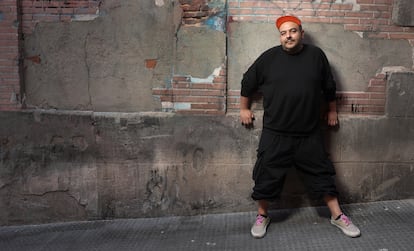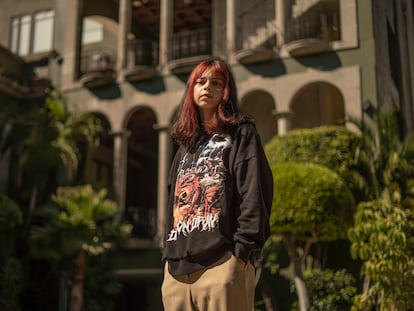Mexican Institute of Sound: ‘Mexico flourishes when everything seems darkest’
Musician, singer and producer Camilo Lara is one of today’s most important figures in Latin American music, thanks to a proposal that is as fresh as it is authentic

The music of Camilo Lara, who calls himself Instituto Mexicano del Sonido (Mexican Institute of Sound), is like the tasting menu of a fine restaurant that lets you try everything in small plates: cumbia, punk, electronic, rock or hip hop, “but roughly prepared, with left-handed scissors and mixed in naco [tacky],” he laughs. Musician, singer and producer, Lara is one of today’s most prominent names in Latin American music thanks to the genuine way in which he mixes folklore and modernity while sniffing out and finding new talent “like a truffle dog.”
As a producer, such disparate artists as Lila Downs, Norah Jones, Beck, Graham Coxon (Blur) or the Beastie Boys have passed through his hands, and as a musician his concerts attract a legion of enthusiasts captured, sect-style, by his hypnotic combinations of huarache and tuxedo. He began DJing in Madrid with some friends, and in recent years he has been sought by the industry with assignments as diverse as scoring the films Coco or Y tu mamá también (for which he was nominated for a Grammy) or intervening the best-selling video game of all time, Grand Theft Auto V. His latest work is a love letter to Mexico City, and he just kicked off a new tour in Spain.
Question. The only statue in Madrid dedicated to a musician is of a Mexican and bears your last name.
Answer. Agustín Lara [laughs]. I feel at home in Madrid.
Q. The first mass phenomenon in Spain was Jorge Negrete arriving in Madrid. Why do we like Mexican music so much?
A. There has always been a phenomenon of reciprocity between the two countries, as if it were a homing pigeon that carries popular music, son, rock or pop, in its beak. It’s a healthy theft, driven by our strong cultural connection. We share a cultural DNA, whether governments and politicians like it or not.
Q. What is Mexican music made of?
A. For me, there are two fundamental ingredients: the rhythm, which includes the sounds of the Caribbean, such as cumbia or tropical music, and the lyrical part, provided by bolero, son or hip hop. In the end there are two things: the head and the dance, and Mexicans are always debating between the two.
Q. Your latest album is a love letter to Mexico City. How is something like this constructed, musically?
A. It’s a city that has been built and destroyed many times. From earthquakes to invasions; from Tenochtitlan [the former capital of the Aztec empire] to the current CDMX. My life is the same; a bunch of mixed layers. I do feel attached to it.
Q. Is Mexico City badly told and badly sung? Should it change its press officer?
A. [Laughs] Mexico City is the place where all those who want to become something in the world of music in Mexico come together. That’s the case for the locals, and for decades it was also the case for any Latin American who wanted to succeed, like Bola de nieve, Pérez Prado, Benny More or Chavela Vargas. It’s the last frontier if you want to be somebody in music.
Q. What do you mean when you say that Juan Gabriel and Morrissey (The Smiths) are alike?
A. Chicanos and Mexican Americans are fascinated by Morrissey. The similarities between the two are quite strong: they both tend to mock death, are ironic, laugh when it’s time to cry and play with sexual ambiguity, which is so interesting in Mexico, a tremendously sexist society.
Q. Is José Alfredo Jiménez the first punk rocker?
A. Certainly. His way of living and understanding love made him our Johnny Cash.

Q. Of everything that is happening musically in Mexico, what should we be paying attention to?
A. There are many things going on at the same time. First, neo-folklorists like Silvana Estrada, experimentalists like Mabe Fratti and Dolores Huerta, or the hip hop scene, with lots of people doing incredible things. And, of course, Mexican regional artists like Peso Pluma, Natanael or Calle X vida. The most interesting thing is that each genre is very different from the other.
Q. And corrido tumbado? What do you think?
A. I find it fascinating. It’s a fascinating phenomenon from an incredible generation of 20 or 25 year olds who understand music and business in a different way. They are very smart; they know the streets and how to make a living by creating their own industry.
Q. Does everything you touch turn into gold?
A. I see myself as a truffle dog [laughs]. I can spot talent. I am lucky because what I used to like, which was countercultural at the time, became important. Decades ago, when I played cumbia, which was considered a tacky genre among the middle classes, people jeered at me; but it later ended up succeeding.
Q. The decades go by and Mexican culture continues to be the main export product.
A. Mexico has the ability to flourish when everything seems darkest. When Trump arrived and being a Mexican seemed like a horrible thing, or when [former president] Felipe Calderón’s war on drugs began and the deaths and disappearances came, the movie Coco appeared, which is a love letter to Mexico; Mexican cuisine took off; and cumbia regia took the big leap. For a few years, this flourishing was the best there was in the country.
Q. Is it a cliché to say that Latin music is at its best moment?
A. It has more visibility than ever; that is undeniable. These things were already happening before, but now they are more visible. We are experiencing the end of America and the Saxon dictatorship. Culture now comes from Nigeria, Korea, Colombia, Mexico.
Q. Until you all came, it seemed that everything began and ended with the mariachi.
A. The mariachi was a construction of the “golden age of Mexican cinema” in its attempt to shape the values of the Mexican of the future. It was a character that was inclined to fall in love, mischievous, tough and stern but at the same time affectionate. The mariachi was created in the Mexican Hollywood, and José Alfredo is part of that.
Sign up for our weekly newsletter to get more English-language news coverage from EL PAÍS USA Edition
Tu suscripción se está usando en otro dispositivo
¿Quieres añadir otro usuario a tu suscripción?
Si continúas leyendo en este dispositivo, no se podrá leer en el otro.
FlechaTu suscripción se está usando en otro dispositivo y solo puedes acceder a EL PAÍS desde un dispositivo a la vez.
Si quieres compartir tu cuenta, cambia tu suscripción a la modalidad Premium, así podrás añadir otro usuario. Cada uno accederá con su propia cuenta de email, lo que os permitirá personalizar vuestra experiencia en EL PAÍS.
¿Tienes una suscripción de empresa? Accede aquí para contratar más cuentas.
En el caso de no saber quién está usando tu cuenta, te recomendamos cambiar tu contraseña aquí.
Si decides continuar compartiendo tu cuenta, este mensaje se mostrará en tu dispositivo y en el de la otra persona que está usando tu cuenta de forma indefinida, afectando a tu experiencia de lectura. Puedes consultar aquí los términos y condiciones de la suscripción digital.
More information
Archived In
Últimas noticias
David Bowie, the galactic thinker who encouraged us to break new ground
John Berger and the loss of rural culture
From police officer to bloodthirsty kidnapper: Terror in Mexico during the years of ‘The Ear Chopper’
Alain Aspect, Nobel laureate in physics: ‘Einstein was so smart that he would have had to recognize quantum entanglement’
Most viewed
- David King, chemist: ‘There are scientists studying how to cool the planet; nobody should stop these experiments from happening’
- Reinhard Genzel, Nobel laureate in physics: ‘One-minute videos will never give you the truth’
- Oona Chaplin: ‘I told James Cameron that I was living in a treehouse and starting a permaculture project with a friend’
- Sinaloa Cartel war is taking its toll on Los Chapitos
- Mexico completes its trade shift with the entry into force of tariffs on China and countries without trade agreements











































